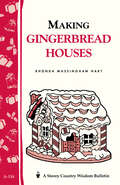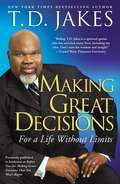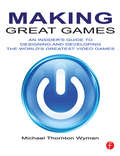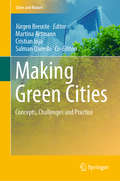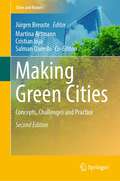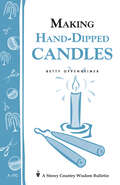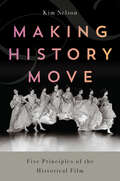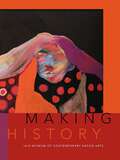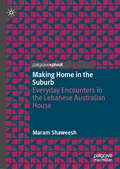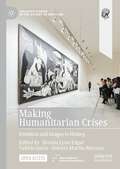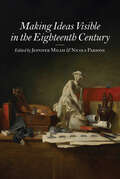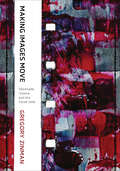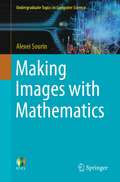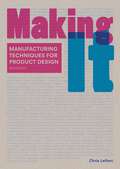- Table View
- List View
Making Gingerbread Houses: Storey Country Wisdom Bulletin A-154 (Storey Country Wisdom Bulletin Ser.)
by Rhonda Massingham HartSince 1973, Storey's Country Wisdom Bulletins have offered practical, hands-on instructions designed to help readers master dozens of country living skills quickly and easily. There are now more than 170 titles in this series, and their remarkable popularity reflects the common desire of country and city dwellers alike to cultivate personal independence in everyday life.
Making Grapevine Wreaths: Storey's Country Wisdom Bulletin A-150
by Gayle O'DonnellSince 1973, Storey's Country Wisdom Bulletins have offered practical, hands-on instructions designed to help readers master dozens of country living skills quickly and easily. There are now more than 170 titles in this series, and their remarkable popularity reflects the common desire of country and city dwellers alike to cultivate personal independence in everyday life.
Making Great Decisions Reflections: For a Life Without Limits
by T.D. JakesThe star of BETs Mind, Body & Soul, and featured guest speaker on Oprah’s Lifeclass, Potter’s House pastor, T.D. Jakes turns his attention to the topic of relationships, guiding you on the right track to making decisions you will benefit from for the rest of your life. In the vein of Joel Osteen’s Become a Better You and Dr. Phil’s Life Strategies, the New York Times bestselling Making Great Decisions (formerly tiled Before You Do) gives you the psychological and practical tools you need to reflect, discern, and decide the next step toward strong relationships in your life. “Remember,” writes T.D. Jakes, “your tomorrow is no better than the decisions you make today.” “My promise is that if you read this book, you will be equipped, you will know all you need to know about making foolproof relational decisions,” writes T.D. Jakes. Choosing the right partner, at home or at work, is one of the most consequential decisions we’ll ever make. How can we be sure that we’re choosing wisely? How do we know if we’re doing the right thing when we change careers? By breaking our decisions down into their five crucial components: Research: gathering information Roadwork: removing obstacles Rewards: listing choices and visualizing consequences Revelation: narrowing your options and making your selection Rearview: looking back and adjusting as necessary to stay on course Clear-sighted, realistic, and spiritually uplifting, Making Great Decisions is one of those rare books that can change lives.
Making Great Decisions: For a Life Without Limits
by T.D. JakesNew York Times bestselling author T.D. Jakes explains the tools that we need to know—whether we&’re single and looking to have a committed relationship or already married—before taking the next big step.The star of BET&’s Mind, Body & Soul, and featured guest speaker on Oprah&’s Lifeclass, Potter&’s House pastor, T.D. Jakes turns his attention to the topic of relationships, guiding you on the right track to making decisions you will benefit from for the rest of your life. In the vein of Joel Osteen&’s Become a Better You and Dr. Phil&’s Life Strategies, the New York Times bestselling Making Great Decisions gives you the psychological and practical tools you need to reflect, discern, and decide the next step toward strong relationships in your life. &“Remember,&” writes T.D. Jakes, &“your tomorrow is no better than the decisions you make today.&” &“My promise is that if you read this book, you will be equipped, you will know all you need to know about making foolproof relational decisions,&” writes T.D. Jakes. Choosing the right partner, at home or at work, is one of the most consequential decisions we&’ll ever make. How can we be sure that we&’re choosing wisely? How do we know if we&’re doing the right thing when we change careers? By breaking our decisions down into their five crucial components: -Research: gathering information -Roadwork: removing obstacles -Rewards: listing choices and visualizing consequences -Revelation: narrowing your options and making your selection -Rearview: looking back and adjusting as necessary to stay on course Clear-sighted, realistic, and spiritually uplifting, Making Great Decisions is one of those rare books that can change lives.
Making Great Games: An Insider's Guide to Designing and Developing the World's Greatest Games
by Michael Thornton WymanJoin videogame industry veteran Michael Thornton Wyman on a series of detailed, behind-the-scenes tours with the teams that have made some of the most popular and critically acclaimed videogames of the modern era. Drawing on insider's perspectives from a wide variety of teams, learn about the creation of a tiny, independent game project (World of Goo), casual game classics (Diner Dash, Bejeweled Twist), the world's most popular social game (FarmVille) as well as the world's most popular MMORPG (World of Warcraft), PC titles (Half Life 2) to AAA console games (Madden NFL 10), and modern-day masterpieces (Little Big Planet, Rock Band, Uncharted 2: Among Thieves). Hear directly from the creators about how these games were made, and learn from their stories from the trenches of videogames production. This book is an excellent resource for those working directly on game design or production, for those aspiring to work in the field, or for anyone who has wondered how the world's greatest videogames get made.
Making Green Cities: Concepts, Challenges and Practice (Cities and Nature)
by Jürgen Breuste Martina Artmann Cristian Ioja Salman QureshiThis book shows what role nature can play in a city and how this can make it a better place for people to live. People, planners, designers and politicians are working towards the development of green cities. Some cities are already promoted as green cities, while others are on their way to become one. But their goals are often unclear and can include different facets. Presenting contributions from world leading researchers in the field of urban ecology, the editors provide an interdisciplinary overview of best practices and challenges in creating green cities. They show examples of how to build up these cities from bits and pieces to districts and urban extensions. Each example concludes with a summary of the collected knowledge, the learning points and how this can be used in other places. The best practices are collected from around the world – Europe, Australia, America and Asia. The new dynamic urban development of Asia is illustrated by case studies from China and the Indian subcontinent. The reader will learn which role nature can play in green cities and what the basic requirements are in terms of culture, pre-existing nature conditions, existing urban surroundings, history, design and planning.
Making Green Cities: Concepts, Challenges and Practice (Cities and Nature)
by Jürgen Breuste Martina Artmann Cristian Ioja Salman QureshiThis book shows what role nature can play in a city and how this can make it a better place for people to live. People, planners, designers and politicians are working towards the development of green cities. Some cities are already promoted as green cities, while others are on their way to become one. But their goals are often unclear and can include different facets. Presenting contributions from world leading researchers in the field of urban ecology, the editors provide an interdisciplinary overview of best practices and challenges in creating green cities. They show examples of how to build up these cities from bits and pieces to districts and urban extensions. Each example concludes with a summary of the collected knowledge, the learning points and how this can be used in other places. The best practices are collected from around the world – Europe, America and Asia. Contributions cover a wide range of biophysical and cultural backgrounds within these three continents, including the Central, Southern and Eastern European region, as well as Latin and North America. The new dynamic urban development of Asia is illustrated by case studies from China and the Indian subcontinent. The reader will learn which role nature can play in green cities and what the basic requirements are in terms of culture, pre-existing nature conditions, existing urban surroundings, history, design and planning.
Making Hand-Dipped Candles: Storey's Country Wisdom Bulletin A-192 (Storey Country Wisdom Bulletin Ser.)
by Betty OppenheimerSince 1973, Storey's Country Wisdom Bulletins have offered practical, hands-on instructions designed to help readers master dozens of country living skills quickly and easily. There are now more than 170 titles in this series, and their remarkable popularity reflects the common desire of country and city dwellers alike to cultivate personal independence in everyday life.
Making Healthy Places
by Richard J. Jackson Andrew L. Dannenberg Howard FrumkinThis book provides a far-reaching follow-up to the pathbreaking Urban Sprawl and Public Health, published by Island Press in 2004. That book sparked a range of inquiries into the connections between constructed environments, particularly cities and suburbs, and human health. Since then, numerous studies have extended and refined the book's research and reporting. Making Healthy Places offers a fresh and comprehensive look at this vital subject today, from the scale of buildings up to the scale of metropolitan areas. There is no other book with the depth, breadth, vision and accessibility that this book offers. Like a well-trained doctor, it presents a diagnosis of-and offers treatment for-problems related to the built environment. Drawing on the latest scientific evidence, with contributions from experts in a range of fields, it imparts a wealth of practical information, emphasizing demonstrated and promising solutions to common problems. Health professionals, planners, architects, developers, elected officials, students, and concerned members of the public will find this book invaluable.
Making Healthy Places: Designing and Building for Health, Well-being, and Sustainability
by Richard J. Jackson Andrew L. Dannenberg Howard Frumkin Emil Malizia Arthur Wendel Robin Fran AbramsThe environment that we construct affects both humans and our natural world in myriad ways. There is a pressing need to create healthy places and to reduce the health threats inherent in places already built. However, there has been little awareness of the adverse effects of what we have constructed-or the positive benefits of well designed built environments. This book provides a far-reaching follow-up to the pathbreaking Urban Sprawl and Public Health, published in 2004. That book sparked a range of inquiries into the connections between constructed environments, particularly cities and suburbs, and the health of residents, especially humans. Since then, numerous studies have extended and refined the book's research and reporting. Making Healthy Places offers a fresh and comprehensive look at this vital subject today. There is no other book with the depth, breadth, vision, and accessibility that this book offers. In addition to being of particular interest to undergraduate and graduate students in public health and urban planning, it will be essential reading for public health officials, planners, architects, landscape architects, environmentalists, and all those who care about the design of their communities. Like a well-trained doctor, Making Healthy Places presents a diagnosis of--and offers treatment for--problems related to the built environment. Drawing on the latest scientific evidence, with contributions from experts in a range of fields, it imparts a wealth of practical information, with an emphasis on demonstrated and promising solutions to commonly occurring problems.
Making Healthy Places: Designing and Building for Well-Being, Equity, and Sustainability
by Andrew L. Dannenberg Howard Frumkin Nisha BotchweyThe first edition of Making Healthy Places offered a visionary and thoroughly researched treatment of the connections between constructed environments and human health. Since its publication over 10 years ago, the field of healthy community design has evolved significantly to address major societal problems, including health disparities, obesity, and climate change. Most recently, the COVID-19 pandemic has upended how we live, work, learn, play, and travel. <p><p>In Making Healthy Places, Second Edition: Designing and Building for Well-Being, Equity, and Sustainability, planning and public health experts Nisha D. Botchwey, Andrew L. Dannenberg, and Howard Frumkin bring together scholars and practitioners from across the globe in fields ranging from public health, planning, and urban design, to sustainability, social work, and public policy. This updated and expanded edition explains how to design and build places that are beneficial to the physical, mental, and emotional health of humans, while also considering the health of the planet. <p><p>This edition expands the treatment of some topics that received less attention a decade ago, such as the relationship of the built environment to equity and health disparities, climate change, resilience, new technology developments, and the evolving impacts of the COVID-19 pandemic. <p><p>Drawing on the latest research, Making Healthy Places, Second Edition imparts a wealth of practical information on the role of the built environment in advancing major societal goals, such as health and well-being, equity, sustainability, and resilience. <p><p>This update of a classic is a must-read for students and practicing professionals in public health, planning, architecture, civil engineering, transportation, and related fields.
Making History Move: Five Principles of the Historical Film
by Kim NelsonMaking History Move: Five Principles of the Historical Film builds upon decades of scholarship investigating history in visual culture by proposing a methodology of five principles to analyze history in moving images in the digital age. It charts a path to understanding the form of history with the most significant impact on public perceptions of the past. The book develops insights across these fields, including philosophical considerations of film and history, to clarify the form and function of history in moving images. It addresses the implications of the historical film on public historical consciousness, presenting criteria to engage and assess the truth status of depictions of the past. Each chapter offers a detailed aspect of this methodology for analyzing history in moving images. Together, they propose five principles to organize past and future scholarship in this vital, interdisciplinary field of study.
Making History: IAIA Museum of Contemporary Native Arts
by Institute of American Indian ArtsMaking History: The IAIA Museum of Contemporary Native Arts is a unique contribution to the fields of visual culture, arts education, and American Indian studies. Written by scholars actively producing Native art resources, this book guides readers—students, educators, collectors, and the public—in how to learn about Indigenous cultures as visualized in our creative endeavors. By highlighting the rich resources and history of the Institute of American Indian Arts, the only tribal college in the nation devoted to the arts whose collections reflect the full tribal diversity of Turtle Island, these essays present a best-practices approach to understanding Indigenous art from a Native-centric point of view. Topics include biography, pedagogy, philosophy, poetry, coding, arts critique, curation, and writing about Indigenous art.Featuring two original poems, ten essays authored by senior scholars in the field of Indigenous art, nearly two hundred works of art, and twenty-four archival photographs from the IAIA&’s nearly sixty-year history, Making History offers an opportunity to engage the contemporary Native Arts movement.
Making History: Quilts & Fabric from 1890–1970
by Barbara BrackmanThis wide-ranging book shows how to create quilts with an authentic antique look, collect period textiles, while revealing the history of American fabrics. Learn the fascinating true story of fabrics in America and make your own period quilts with this comprehensive guide to fabrics and their influence on American quilts, from the machine age to the atomic age. From quilt historian Barbara Brackman, author of America's Printed Fabrics 1770–1890,Making History not only includes 9 quilt projects inspired by vintage quilt designs and fabrics, but is packed with historic photos, stories, and insights into the role of fabrics in everyday life.
Making Holiday Wreaths: Storey's Country Wisdom Bulletin A-262 (Storey Country Wisdom Bulletin Ser.)
by Juliette RogersWhether you want to create a beautiful wreath from scratch or quickly adorn a pre-made wreath base, you'll find all the instruction you need in Making Holiday Wreaths. Learn how to make a boxwood wreath entwined with holly and ivy to grace the front door. Craft balsam wreaths to fill your home with the sweet scent of the forest. Hang gaily decorated wreaths from doors, windows, and mirror frames, or display them on mantels and tabletops. And don't limit your holiday cheer to the house - wrap an evergreen garland around the post of your mailbox, craft a wreath to encircle your birdbath, or clip a row of whimsical wreaths along your clothesline. You can even put out a wreath filled with delectable tidbits to delight your backyard birds!
Making Hollywood Happen: Seventy Years of Film Finances (Wisconsin Film Studies)
by Charles DrazinFilmmaking is a business—someone has to pay the bills. For much of the industry’s history, that role was shouldered by the studios. The rise of independent filmmakers then led to the rise of independent financiers. But what happens if bad weather closes down a production or a director’s vision pays no heed to the limitations of time and money? Enter Film Finances. The company was founded in London in 1950 to insure against the risk that a film would exceed its original budget or not be completed on time. Its pioneering development of the “completion guarantee”—the financial instrument that provides the essential security for investors to support independent filmmaking—ultimately led to the creation of many thousands of films, including some of the most celebrated ever made: Moulin Rouge (1953), Dr. No (1962), The Outsiders (1982), Pulp Fiction (1994), Slumdog Millionaire (2008), La La Land (2016), and more. Film Finances’s role in filmmaking was little known outside the industry until 2012, when it opened its historical archive to scholars. Drawing on these previously private documents as well as interviews with its executives, Making Hollywood Happen tells the company’s story through seven decades of postwar cinema history and chronicles the growth of the international independent film industry. Focusing on a business that has operated at the meeting point between money and art for more than seventy years, this lavishly illustrated book goes to the heart of how the movie business works.
Making Home in the Suburb: Everyday Encounters in the Lebanese Australian House
by Maram ShaweeshThis book investigates everyday life within Lebanese Australian homes, documenting how these homes integrate Lebanese Australian culture into suburban Australian life. It explores how the homemaking practices of Lebanese Australian families both influence and are influenced by the context of suburban housing in Australia. Drawing from in-depth interviews, household tours, photographic documentation, mental mapping, and historical imagery data collection, the book illuminates homemaking practices that have evolved from creating a "home away from home" to practices influenced by a unique Lebanese Australian lifestyle, rooted in the perception of Australia as their home.
Making Homes: Ethnography and Design (Home Ser.)
by Sarah Pink Roxana Morosanu Val Mitchell Tracy Bhamra Kerstin Leder MackleyMaking Homes: Anthropology and Design is a strong addition to the emerging field of design anthropology. Based on the latest scholarship and practice in the social sciences as well as design, this interdisciplinary text introduces a new design ethnography which offers unique and original approaches to research and intervention in the home.Presenting a coherent theoretical and methodological framework for both ethnographers and designers, the authors examine ‘hot’ topics – ranging from movements and mobilities to im/material environments, to digital culture – and confront the challenges of a research and design environment which seeks to bring about the changes required for a sustainable, resilient, ‘safe’, and comfortable future.Written by leading experts in the field, the book draws on real-life examples from a wide range of international projects developed by the authors, other researchers, and designers. Illustrations throughout help to convey the methods and research visually. Readers will also have access to a related website which follows the authors’ ongoing research and includes video and written narrative examples of ethnographic research in the home.Transforming current understandings of the home, this is an essential read for students and researchers in fields such as design, anthropology, human geography, sociology, and media and communication studies.
Making Humanitarian Crises: Emotions and Images in History (Palgrave Studies in the History of Emotions)
by Dolores Martín-Moruno Brenda Lynn Edgar Valérie GorinThis open access collection of essays explores the emotional agency of images in the construction of ‘humanitarian crises’ from the nineteenth century to the present. Using the prism of the histories of emotions and the senses, the chapters examine the pivotal role images have in shaping cultural, social and political reactions to the suffering of others and to the establishment of the international networks of solidarity. Questioning certain emotions assumed to underlie humanitarianism such as sympathy, empathy and compassion, they demonstrate how the experience of such emotions has shifted over time. Understanding images as emotional objects, contributors from a wide horizon of disciplines explore how their production, circulation and reception has been crucial to the perception of humanitarian crises in a long-term historical perspective.
Making Ideas Visible in the Eighteenth Century (Studies in Seventeenth- and Eighteenth-Century Art and Culture)
by Matthew J. Martin Melanie Cooper Jennifer Milam Wiebke Windorf Jessica Priebe David Maskill Jessica Fripp Jennifer FerngThis volume considers how ideas were made visible through the making of art and visual experience occasioned by reception during the long eighteenth century. The event that gave rise to the collection was the 15th David Nochol Smith Seminar in Eighteenth-Century Studies, which launched a new Australian and New Zealand Society of Eighteenth-Century Studies. Two strands of interest are explored by the individual authors. The first four essays work with ideas about material objects and identity formation, suggesting how the artist's physical environment contributes to the sense of self, as a practicing artist or artisan, as an individual patron or collector, or as a woman or religious outsider. The last four essays address the intellectual work that can be expressed through or performed by objects. Through a consideration of the material formation of concepts, this book explores questions that are implicated by the need to see ideas in painted, sculpted, illustrated, and designed forms. In doing so, it introduces new visual materials and novel conceptual models into traditional accounts of the intellectual history of the Enlightenment.
Making Images Move: Handmade Cinema and the Other Arts
by Gregory ZinmanMaking Images Move reveals a new history of cinema by uncovering its connections to other media and art forms. In this richly illustrated volume, Gregory Zinman explores how moving-image artists who worked in experimental film pushed the medium toward abstraction through a number of unconventional filmmaking practices, including painting and scratching directly on the film strip; deteriorating film with water, dirt, and bleach; and applying materials such as paper and glue. This book provides a comprehensive history of this tradition of "handmade cinema" from the early twentieth century to the present, opening up new conversations about the production, meaning, and significance of the moving image. From painted film to kinetic art, and from psychedelic light shows to video synthesis, Gregory Zinman recovers the range of forms, tools, and intentions that make up cinema’s shadow history, deepening awareness of the intersection of art and media in the twentieth century, and anticipating what is to come.
Making Images with Mathematics (Undergraduate Topics in Computer Science)
by Alexei SourinThis textbook teaches readers how to turn geometry into an image on a computer screen. This exciting journey begins in the schools of the ancient Greek philosophers, and describes the major events that changed people’s perception of geometry. The readers will learn how to see geometry and colors beyond simple mathematical formulas and how to represent geometric shapes, transformations and motions by digital sampling of various mathematical functions.Special multiplatform visualization software developed by the author will allow readers to explore the exciting world of visual immersive mathematics, and the book software repository will provide a starting point for their own sophisticated visualization applications. Making Images with Mathematics serves as a self-contained text for a one-semester computer graphics and visualization course for computer science and engineering students, as well as a reference manual for researchers and developers.
Making India: Colonialism, National Culture, and the Afterlife of Indian English Authority
by Makarand R. ParanjapeCompared to how it looked 150 years ago at the eve of the colonial conquest, today's India is almost completely unrecognizable. A sovereign nation, with a teeming, industrious population, it is an economic powerhouse and the world's largest democracy. It can boast of robust legal institutions and a dizzying plurality of cultures, in addition to a lively and unrestricted print and electronic media. The question is how did it get to where it is now? Covering the period from 1800 to 1950, this study of about a dozen makers of modern India is a valuable addition to India's cultural and intellectual history. More specifically, it shows how through the very act of writing, often in English, these thought leaders reconfigured Indian society. The very act of writing itself became endowed with almost a charismatic authority, which continued to influence generations that came after the exit of the authors from the national stage. By examining the lives and works of key players in the making of contemporary India, this study assesses their relationships with British colonialism and Indian traditions. Moreover, it analyzes how their use of the English language helped shape Indian modernity, thus giving rise to a uniquely Indian version of liberalism. The period was the fiery crucible from which an almost impossibly diverse and pluralistic new nation emerged through debate, dialogue, conflict, confrontation, and reconciliation. The author shows how the struggle for India was not only with British colonialism and imperialism, but also with itself and its past. He traces the religious and social reforms that laid the groundwork for the modern sub-continental state, proposed and advocated in English by the native voices that influenced the formation India's society. Merging culture, politics, language, and literature, this is a path breaking volume that adds much to our understanding of a nation that looks set to achieve much in the coming century.
Making Is Thinking
by Zoë Gray Yoshiko Nagai Gavin Delahunty Alice Motard Ane Hjort GuttuThis digital publication accompanies the exhibition Making is Thinking that took place at Witte de With Center for Contemporary Art (23 January - 1 May 2011).The publication features a historical perspective on craft by Alice Motard; a short story by Yoshiko Nagai, inspired by Teppei Kaneuji's animation Tower; a conversation between artist Ane Hjort Guttu and Solveig Øvstebø titled The Emancipation of Forms; an essay by Gavin Delahunty on the work of Koki Tanaka and Julia Dault; and an afterword by curator Zoë Gray.
Making It Third Edition
by Chris LefteriA product can be manufactured in many ways, but most designers know a handful of techniques only. With specifically commissioned diagrams, case studies and photographs of the manufacturing process. Making IT uses contemporary design as a vehicle to describe over 120 production processes. Each process is also evaluated in terms of sustainability and its effects on the environment. Making It appeals to product, interior, furniture and graphic designers who need access to a range of production methods, as well as to all students of designs. The expanded edition includes six new processes and a new section on joining.
